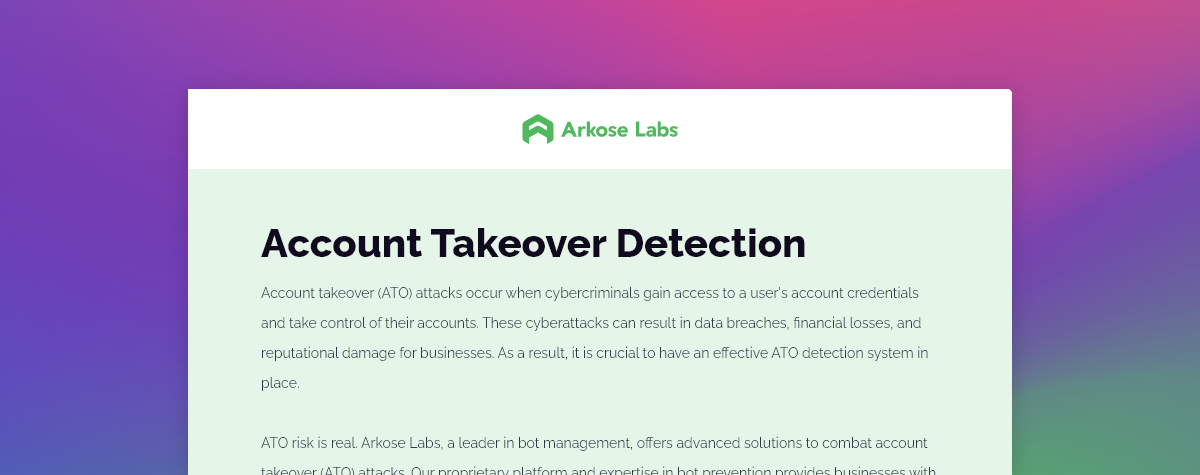Account takeover (ATO) is a growing concern for businesses and individuals alike, with cybercriminals constantly devising new and sophisticated methods to gain access to sensitive data and personal information. From stealing login credentials to exploiting vulnerabilities in systems and applications, ATO scenarios can have serious consequences for both the affected parties and the organizations that serve them. For businesses today, it’s important to understand the various types of ATO attacks, their impact, and best practices for preventing and responding to them.
How does account takeover factor into the rise of cybercrime-as-a-service? Find out in our new eBook: 2023 Cybercrime Prevention Playbook
Understanding account takeover
Account takeover (ATO) is a serious threat that affects both individuals and businesses. It occurs when a hacker gains unauthorized access to a user's account and can lead to financial loss, reputational damage, and loss of customer trust. Hackers use various methods such as phishing scams and password guessing to gain access to accounts, and the consequences can be devastating.
In addition to financial loss, ATOs can result in sensitive data being exposed, making it a priority for businesses to have a response plan in place to mitigate the damage and prevent future attacks.
Why businesses should care about ATOs
Organizations today need to understand account takeovers (ATOs) because they can have serious consequences for the company and its customers. ATO incidents can result in financial losses for the business, as the hackers may use the compromised account to make unauthorized purchases or transfer funds. In addition, ATOs can damage the company's reputation, leading to a loss of customer trust and loyalty. The theft of sensitive information, such as customer data or intellectual property, can also have significant legal and regulatory consequences for businesses.
Furthermore, ATO incidents may violate various data protection and privacy regulations, such as the GDPR or CCPA, which can result in significant fines and legal liabilities for the company. In some cases, businesses may also face lawsuits from affected customers or stakeholders.
To protect their business and customers, businesses need to prioritize cybersecurity measures—such as bot management—that prevent account takeover, such as multi-factor authentication and regular password updates. Additionally, businesses should have a plan in place for responding to an ATO incident, which includes identifying and isolating affected accounts, investigating the incident, and notifying affected customers and stakeholders. By taking these steps, businesses can minimize the impact of ATOs and protect themselves from the potential consequences.
Common targets of account takeover
Account takeover (ATO) is a serious threat that targets a variety of accounts, including personal and business accounts. Hackers and cybercriminals often target accounts that hold sensitive information, have weak security measures, or lack strong authentication protocols.
Small and medium sized businesses (SMBs)
Firstly, SMBs typically have fewer resources dedicated to cybersecurity compared to larger organizations, making them easier targets for hackers. They may also lack the expertise or technical knowledge required to implement robust security measures and protect against ATO attacks. SMBs also tend to use a variety of online accounts and platforms to manage their business operations, such as email, banking, and invoicing systems. This creates a larger attack surface for hackers to exploit, as each account presents a potential vulnerability. Moreover, many SMBs use the same password for multiple accounts, which can make it easier for attackers to gain access to multiple systems and accounts once they have obtained login credentials.
Plus, SMBs may also be seen as easier targets for ATO attacks because they may not be as well-known or well-funded as larger corporations. This can make them less likely to be a priority for cybersecurity investments and may result in less stringent security protocols and training for employees. SMBs may also be more susceptible to social engineering tactics, such as phishing attacks, due to the personal relationships and trust that exist within the organization. Employees may be more likely to fall for a convincing phishing scam if it appears to come from a trusted source, such as a colleague or vendor.
Financial institutions
Financial institutions, such as banks and credit unions, are common targets for account takeover attacks due to the valuable information and assets that they hold. Financial accounts often contain sensitive information, such as personal identification details and financial records, making them attractive targets for hackers. Additionally, financial accounts often hold significant amounts of money, making them a high-value target for attackers seeking to commit fraud or theft.
Many financial institutions may have outdated or inadequate security measures, which can leave them vulnerable to ATO attacks. This is especially true for smaller or regional banks and credit unions, which may not have the same level of resources as larger financial institutions to invest in cybersecurity. As such, they may be more susceptible to attacks such as phishing scams, which can trick employees or customers into providing login credentials or other sensitive information.
Financial institutions are often subject to regulatory requirements and compliance obligations, which can make them a target for ATO attacks. Attackers may seek to gain access to financial accounts to commit money laundering or other illegal activities, which can put the institution at risk of regulatory action or legal liability.
Ecommerce sites
eCommerce sites are common targets for account takeover attacks due to the nature of their business and the valuable information they hold. eCommerce sites typically store sensitive information such as customer names, addresses, phone numbers, and credit card details, making them an attractive target for hackers seeking to commit fraud or identity theft.
In addition, ecommerce sites often have a large customer base and process a high volume of transactions, which provides attackers with a larger pool of potential targets. Attackers may use a variety of tactics to gain access to ecommerce accounts, such as phishing scams, malware, or social engineering, in order to obtain login credentials and other sensitive information.
Another factor that makes ecommerce sites a common target for ATO attacks is the prevalence of password reuse among customers. Many people use the same password across multiple accounts, which can make it easier for attackers to gain access to several accounts once they have obtained login credentials for just one. Ecommerce sites may also be particularly vulnerable to ATO attacks during peak shopping periods, such as holiday sales, when there is an increase in the volume of transactions and a higher likelihood of account compromises.
Methods to detect account takeover fraud
By using a combination of best practices, businesses can detect ATO fraud and take action to prevent further damage. Organizations need a plan in place for responding to ATO incidents, including notifying affected customers and law enforcement, in order to minimize the impact of these attacks.
Suspicious activity monitoring:
By monitoring user accounts and looking for suspicious activity, such as login attempts from unusual locations or devices, businesses can detect potential ATO fraud before significant damage is done. This can be done using automated systems or manual reviews by trained security personnel.
User behavioral biometrics:
By analyzing user behavior biometrics, such as login times and locations, businesses can identify patterns of behavior that may indicate fraudulent activity. For example, a sudden increase in login attempts or changes to account information may indicate ATO fraud.
Device fingerprinting:
Device fingerprinting involves analyzing the unique characteristics of a device, such as the IP address or browser type, to detect potential ATO fraud. This can help identify when a user is attempting to access an account from an unusual or unauthorized device.
Multi-factor authentication:
By requiring users to provide multiple forms of authentication, such as a password and a fingerprint or facial recognition scan, businesses can make it more difficult for attackers to gain access to accounts.
IP geolocation:
By using IP geolocation services, businesses can determine the physical location of an IP address and identify when an account is being accessed from an unusual location.
Account activity monitoring:
By monitoring account activity, such as changes to account information or transaction history, businesses can identify potential ATO fraud and take action to prevent further damage.
Real life scenarios of account takeover
One real-life scenario involves the use of password stealers to gain access to a company's email system. In this case, the attackers used a malicious software program that was able to steal login credentials from employees who had unknowingly installed it on their devices. The attackers were then able to use these stolen credentials to access the company's email system and steal sensitive data, including confidential customer information.
Another common method of ATO is social engineering attacks, which involve tricking individuals into divulging sensitive information. For example, an attacker may send an email that appears to be from a trusted source, such as a bank or online retailer, requesting that the individual click on a link or provide login credentials. Once the attacker has obtained the information, they can use it to gain access to the individual's accounts and commit fraud or identity theft.
Automated bots and scripts are another common method of ATO. These tools are designed to rapidly test large numbers of login credentials in an attempt to gain access to accounts. In some cases, attackers may also use bots and scripts to conduct large-scale phishing attacks or to distribute malware that can be used to steal login credentials.
Prevention and mitigation of account takeovers
Account takeover (ATO) is a growing concern for businesses and individuals, as attackers use increasingly sophisticated methods to gain unauthorized access to accounts. However, there are several steps that businesses can take to prevent and mitigate the risk of ATO.
Implementing multi-factor authentication (MFA)
One of the most effective ways to prevent ATO is to implement multi-factor authentication (MFA). MFA requires users to provide multiple forms of identification, such as a password and a fingerprint, before they can access their accounts. This makes it much more difficult for attackers to gain unauthorized access, as they would need to obtain multiple forms of identification in order to breach the account.
Monitoring and analysis of user behavior
Another important step in preventing ATO is to monitor and analyze user behavior. This involves tracking user activity and identifying any unusual or suspicious behavior, such as multiple failed login attempts or access from an unfamiliar device or location. By monitoring user behavior, businesses can quickly identify and respond to potential ATO incidents, preventing attackers from accessing sensitive data or systems.
Regular training and awareness programs for employees
In addition to technical measures, businesses should also implement regular training and awareness programs for employees. This includes educating employees about the risks of ATO and providing them with best practices for password security, such as using complex passwords and avoiding sharing login credentials. By raising awareness and providing regular training, businesses can help prevent employees from inadvertently contributing to ATO incidents.
How AI-powered solutions can help prevent ATO attacks
AI-powered solutions can play a key role in preventing ATO attacks by providing advanced threat detection and response capabilities. One of the main benefits of AI-powered solutions is their ability to analyze vast amounts of data in real time, allowing them to identify and respond to potential ATO attacks quickly and effectively.
AI-powered solutions can be used to monitor user behavior and detect unusual or suspicious activity, such as failed login attempts, multiple login attempts from different locations, or attempts to access sensitive data or systems outside of normal business hours. By analyzing this data, AI-powered solutions can quickly identify potential ATO attacks and respond with real-time alerts or automatic blocking of suspicious activity.
In addition, AI-powered solutions can also help to identify patterns and trends in ATO attacks, allowing businesses to proactively implement measures to prevent future attacks. For example, by analyzing data on the types of accounts that are most commonly targeted or the methods that attackers use to gain access, AI-powered solutions can help businesses identify vulnerabilities and take steps to mitigate them before an attack occurs.
Arkose Labs for ATOs
Arkose Labs, a leading provider in bot mitigation and prevention, can help businesses protect against ATO, with a platform that leverages advanced AI and machine learning capabilities to identify and block fraudulent activity—including ATO attacks.
One of the key features of the Arkose Labs platform is its ability to identify and block bots and automated scripts that are often used in ATO attacks. By analyzing user behavior and identifying patterns that are indicative of bot activity, the platform can block suspicious activity in real-time, preventing attackers from gaining unauthorized access to accounts.
The Arkose Labs platform also leverages advanced risk scoring and authentication capabilities to prevent ATO attacks. It uses a combination of behavioral biometrics, device fingerprinting, and other advanced authentication techniques to verify user identities and prevent unauthorized access. The platform also provides businesses with real-time insights and analytics on ATO attacks. By analyzing data on the types of attacks that are most common, Arkose Labs can help businesses identify vulnerabilities and take proactive measures to prevent future attacks.
Book a demo today and find out how we can help your business!

Account Takeover Detection
- Understanding account takeover
- Why businesses should care about ATOs
- Common targets of account takeover
- Small and medium sized businesses (SMBs)
- Financial institutions
- Ecommerce sites
- Methods to detect account takeover fraud
- Suspicious activity monitoring:
- User behavioral biometrics:
- Device fingerprinting:
- Multi-factor authentication:
- IP geolocation:
- Account activity monitoring:
- Real life scenarios of account takeover
- Prevention and mitigation of account takeovers
- Implementing multi-factor authentication (MFA)
- Monitoring and analysis of user behavior
- Regular training and awareness programs for employees
- How AI-powered solutions can help prevent ATO attacks
- Arkose Labs for ATOs


